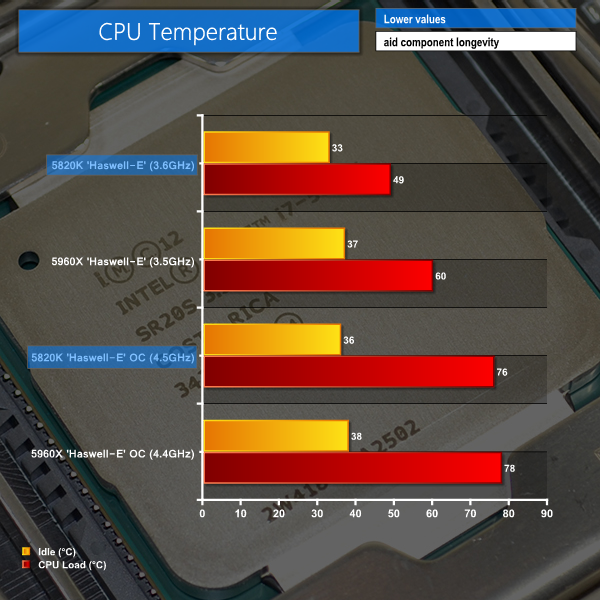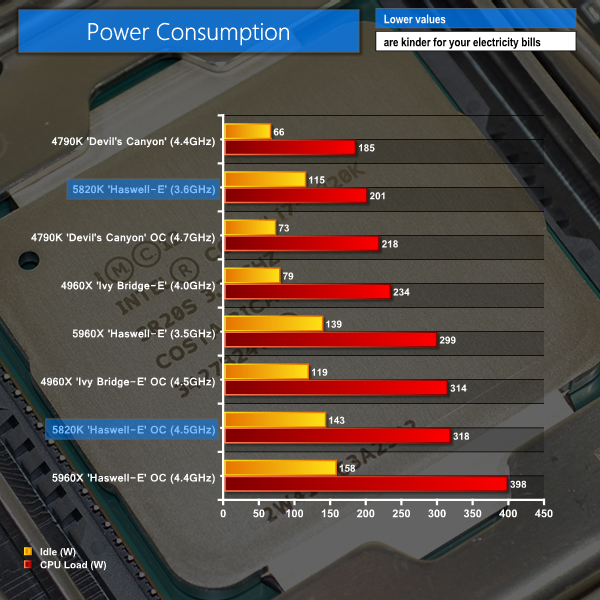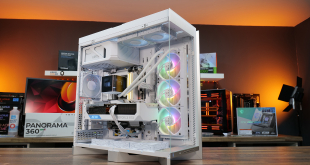We measured the idle temperatures and power consumption levels with the system resting at the Windows 7 desktop.
Processor temperature and the power consumption of our entire test system (at the wall) is measured while loading only the CPU using Prime95′s in-place large FFTs setting.
Asus’ AI Suite 3 software delivered contradictory readings that were sometimes as much as 10°C lower than CPUID's HWMonitor. We opted for HWMonitor's ‘worst-case scenario' readings as a safety measure.
Temperatures
Temperature recordings were taken with the Corsair H100i CPU cooler’s fans running at full speed. Ambient temperature was maintained at a toasty 23°C.
The low – 1.064V – multi-core turbo (MCT) operating VCore on Asus' X99-A motherboard gives the 5820K impressive thermal numbers at stock speeds. If you are not going to push any further than the 3.6GHz MCT frequency, your CPU cooler choice can be constricted to the budget section of the market (something like a Cooler Master Hyper 212 Evo would probably be fine).
Increasing the voltage and clock speed, unsurprisingly, causes a large jump in the processor's load temperature. Our Corsair H100i running at full fan speed was able to keep our 5820K sample at 76°C when fed with up to 1.28V, but the noise level was highly intrusive.
Backing down the fan speed to a more bearable level would cause the chip to pass the 80°C mark.
We ran a brief test with the chip pulling in 1.325V and saw the temperature quickly shoot towards 90°C when a Prime95 load was applied. If you plan on running the VCore at more than 1.325V, full-blooded watercooling should be given serious consideration. But do bear in mind that the silicon lottery also affects a chip's operating temperature.
Power Consumption
We must note that the Haswell-E systems were housed inside an NZXT Phantom 630 chassis with three case fans. The 4790K and 4960X were tested in an open-air environment hence the powering of fans was not required.
Stock (MCT) power consumption for the 5820K is particularly positive. Ignoring the high idle power consumption (which is largely a trait for the Asus X99 motherboard versus IVB-E and Devil's Canyon's MSI alternatives), the six-core Haswell-E chip shows promising load energy usage for such a high-performance part.
Cranking the voltage level is when Haswell-E shows its affection for energy. Load power usage for the 5820K increases by 58% when an additional 0.21V (and increased accompanying voltages) is fed through the chip. With the system pulling 318W from the wall when at full CPU load (and a completely idle graphics card), the importance of a high quality power supply is not to be underestimated when running an overclocked Haswell-E processor. High current on the PSU's 12V rail is also crucial in maintaining sufficient power delivery through the hard-working 8-pin EPS connector.
For the sake of comparison, the overclocked 4960X using a 1.425V VCore was able to pull less power than the voltage-boosted Haswell-E chips. Reports on the web have also shown that the VRM power losses on X99 motherboards are high, and we would not disagree (nor would my surprised index finger) after reading (and feeling) a 70+°C VRM temperature for Asus' loaded X99-A motherboard.
 KitGuru KitGuru.net – Tech News | Hardware News | Hardware Reviews | IOS | Mobile | Gaming | Graphics Cards
KitGuru KitGuru.net – Tech News | Hardware News | Hardware Reviews | IOS | Mobile | Gaming | Graphics Cards





MKV is not a video format, it is a container. What format was the video in for the conversion? Odds are it was already an MP4 encoded using H.264 which was Stored as a stream inside the MKV file – meaning your test was just resampling the original file and not really encoding anything.
You are correct. As suggested, the file uses an MPEG-4 part 10 (H.264) codec and is simply contained within the MKV container. The operation being run is more of a remuxing process than an encode – it takes the H.264 video out of a MKV container and puts it into a MP4 container.
The test results are still perfectly valid and highlight differences in processing power. I will look into a ‘true’ encode test for future usage.
Well, a couple things about video encoding you should probably take into account. 1) Your using Handbreak, which uses Gstreamer, which doesn’t natively use Intel’s Quick Sync Video – but it does Use VCE (the Radeon 280x in your test build supports VCE) 2) so while you where testing the processors ability to pass information along, you won’t actually be testing the SIP components on the Processors unless you use a program that fully utilizes the Gen2 and Gen3 Intel Quick Sync technologies in the IB-E or the Haswell.
So unless you use a program that isn’t routing directly through the video card, you won’t actually be testing the processor with video encoding.
But the issue is that QuickSync doesn’t exist on the platform LGA2011, that is part of the platform 1155/1150 as they have their GPU builtin on the die, unlike the LGA2011 counterparts.
One of the processors being compared here (the 4790k) has Intel Quick Sync. just because the 5820k doesn’t, doesn’t mean the tests used shouldn’t support it. I was also bringing up the fact that any transcoding done on this specific build will utilize the GPU’s video encoding technology and not really be a true representation of the CPU’s encoding ability.
Could somebody help me pls?
I have a sabertooth z97 mark 1 and it is supposed to run 5th gen processor (updating it), but the thing is that the socket the mother has is an 1150 and I see the 5th gen are lga 2011 or 2011-v3. Here comes my question.
After my BIOS is upgraded it’s supposed to work with the lga 2011 processors?
my i7 5820k at stock speeds idles at around 29 degrees celcius with an h100i and all case fans at max. is that ok???
That’s typical, provided the ambient temperature is in the low 20s. Mine’s currently at 4.5ghz idles around 33c with a custom loop
Denise, I imagine you’ve gotten the answer to this question by now, but the 1150 and the 2011 sockets are unfortunately physically different so a BIOS update will not let you use any of the Haswell-E CPU’s in the 1150 socket.